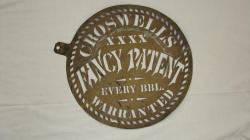
E.H. Lowell, West Farmington, Maine
This stencil was used to mark crates and barrels.Farmington Historical Society
The Lowell homestead was on the Whittier Road, (now # 655 Whittier Road). “The orchards had 1,000 or more trees and each fall Lowell bought up Spies and Baldwins (apples) from others and shipped them by the carload to Boston." From there they were "sent to England and sold at top prices.”
In 1872, the first refrigerated rail car came to Farmington. The car’s walls were lined with charcoal (which did not conduct the outside heat to the inside of the car) and ice was placed in a tube on either side of each door. The advancement in refrigerated cars made the export of meat possible as well as improved the condition of eggs and fruit.
Hervey Lowell built up such a large egg business, that he built an egg house near the store. The egg house had sawdust insulation in the walls and an ice bunk in the center. The wooden egg cases were kept cool, awaiting shipment to Boston markets.
Whole herds of cattle and flocks of sheep were bought by Hervey Lowell, which he kept at the homestead. Tons of wool were bought and shipped to outside markets as well.
Farmington not only exported goods, but had to import as well. Goods were needed to support the agricultural and logging businesses. One newspaper article states, “Due to the amount of livestock, it takes a lot of grain to feed working teams of horses and oxen.” (Teams were not only on farms but were working in the woods logging). Lowell’s bought oats and corn in lots of five or six carloads. They bought flour by the carload too. It is written that in the early 1890’s, “one car Royal Gem, one car Taylor’s Fancy Patent, just received direct form the mills and to be sold very low for cash or exchange of produce. The wooden barrels in which it came became too expensive and hard to handle and have been wholly replaced by the paper sacks which hold five, 10 or 25 pounds.”

Croswell Fancy Patent Stencil
The Croswell Store, located in Farmington Falls, used this stencil to mark barrels.Farmington Historical Society
The railroad allowed the export of farm products south to Portland, Boston and Brighton, MA, and as far away as England. West Farmington, the terminus of the Maine Central Rail Road, developed a cattle yard, creamery (Pictur-of W. Farm. Yard with horses, wagons, milk cans-needed) and brought new business to Lowell’s Store.

Croswell's Store c. 1890
Located in Farmington Falls, Croswell's Store opened in 1816. The store was run by the Croswell family until 1958. The original store can be seen in the back, attached to the front building.Farmington Historical Society
In 1859, Franklin County exported $92,000 worth of apples, the equivalent of $2 million today.
The Androscoggin (later Maine Central) railroad crossed the Sandy River in 1870 to the train depot on Front St. By 1879, this standard gauge railroad connected with the Sandy River Narrow Gauge Company rail system. The narrow gauge rail system that was laid, came from a bankrupt railroad between Bedford and Billerica, MA. The narrow gauge ran from Farmington to Phillips, ME, helping to open up the famed Rangeley Lakes to tourists.
The narrow gauge system expanded throughout Franklin County, bringing goods and people north and wood south. The Sandy River narrow gauge railroad ceased operating in 1935 and the Maine Central RR ran its last passenger train in 1957. The train continued a daily trip to Farmington to collect milk and cream at the creamery in West Farmington until the 1970s. The rails were dismantled in 1982.